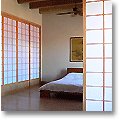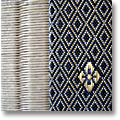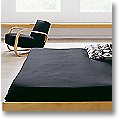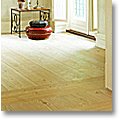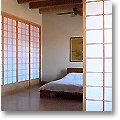Japanese Bedroom Design: Traditional & Contemporary Bedrooms In Japan
A Japanese bedroom ('washitsu' = old-style Japanese room) is a bedroom only by night. It is designed to be multi-functional. Furnished with tatami floor mats and fitted wall closets, it contains no particular bedroom furniture or decor.
Similar bedroom designs here: Cool & simple Asian inspired bedrooms / vibrant Asian-Theme bedroon designs / Zen Bedroom ideas (non-Japanese).
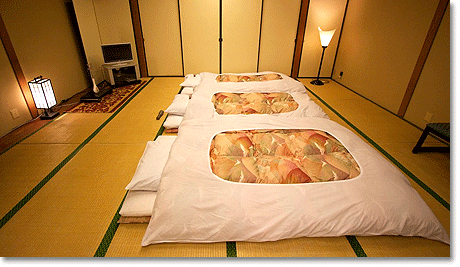
Washitsu (= Japanese style room) in Kyoto-shi, Kyoto Prefecture (Japan):
Traditional futon bedding on a tatami floor. © Mathieu Thouvenin
Here is the same room as above, but set with portable dining furniture:
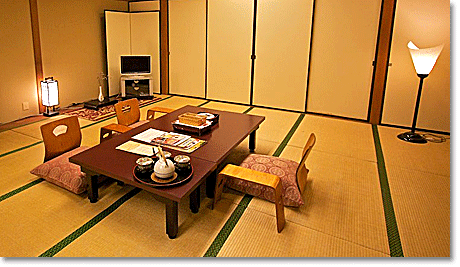
Japanese washitsu, set for a meal. © Mathieu Thouvenin
Traditional Japanese bedding is always laid out directly on the floor mats. There is no slatted frame or bedstead. Therefore, shoes are taboo in a washitsu.
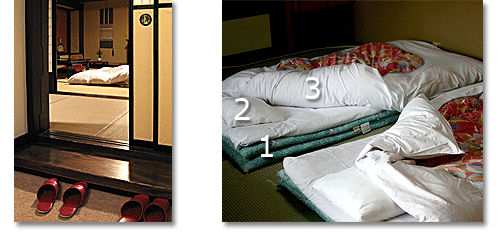
Traditional Japanese bedrooms. © left: Josh; right: Christian Kadluba
A Japanese bed (=futon) consists of:
(1) The shikibuton (bottom mattress - in the photo right, it's a stack of three!) The shikibuton is traditionally filled with cotton batting. What's called a 'futon' in the West is basically a thicker, chunkier version of the shikibuton.
(2) The makura (pillow), which is stuffed with buckwheat husks or beans, or - in these modern times - with plastic beads;
(3) The kakebuton is the comforter, to which you can add a mofu (blanket) when it's cold.
For centuries, this has been how you make your bed in Japan. Whether you're an aristocrat, a farmer, an office worker or a Zen monk, you spread your futon directly onto the tatami floor mats. One mat (roughly 3'x 6') counts as the sleeping space for one person.
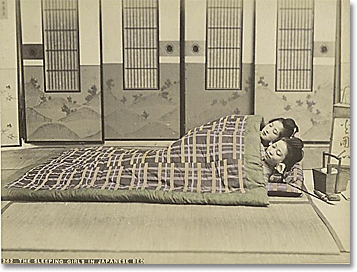
Japanese bedroom, c. 1890s © New York Public Library
This historic photo of a Japanese bedroom dates from the 1890s - and it's obviously staged - but you can clearly see that the general setup of a Japanese bedroom hasn't changed much in the past 120+ years!
Every morning, the entire futon is folded, stacked & stowed into one of the built-in closets. That way, you free the room up for other purposes. (More about this in an artcile about Zen Interiors, coming soon!)
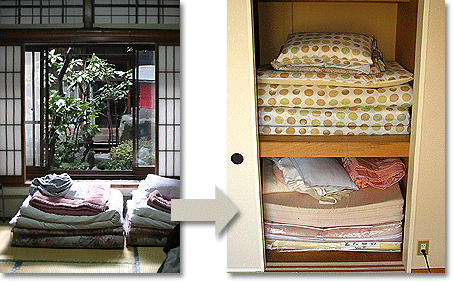
Futon, piled up (© Josh Newman) & stashed away (© Sean)
For hygienic reasons, a futon needs to be exposed to sunlight and aired regularly. This is the typical look of Japanese neighborhoods on a fine day:
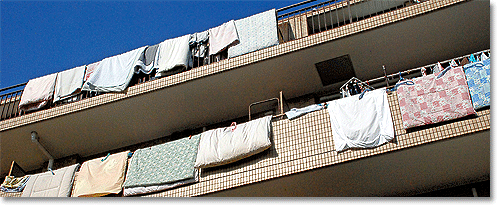
Futon airing in Kawasaki, Kanagawa Prefecture (Japan). © Jean-François Chénier
Contemporary Japanese Bedroom Design:
Creating A Calm, Elegant Space
Below are three contemporary versions of the traditional Japanese bedroom. They're quite different in style, but all are gorgeous, and you could easily copy elements of the look in a Western home.
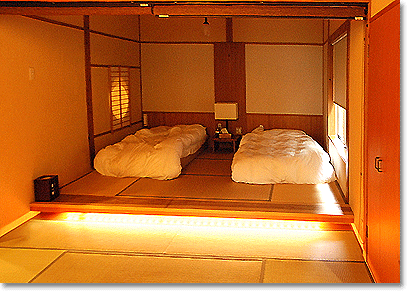
Tatami bedroom in Shuzenji, Honshu (Japan). © Richie Johns
This is a slightly westernized tatami bedroom:
- Even though there are no bedframes, the thin, cotton shikibuton have been replaced by thick, Western-style mattresses. (They look as if they were meant to stay on the floor during the day, rather than be folded up and tucked away);
- There's a nightstand with a Western-style table lamp;
- The sleeping area is on a raised tatami platform;
- Instead of the traditional floor lanterns (see below), there's a string of LED lighting installed under the platform rim. It visually 'lifts' the platform off the ground and gives the room an ethereal look.
Next up, a very interesting contemporary Japanese room design where the shoji sliding door looks like a large window treatment in the wall. There's not a single tatami mat in sight, but the look is unmistakeably Japanese. Also, note the floor level lighting (more of which below):
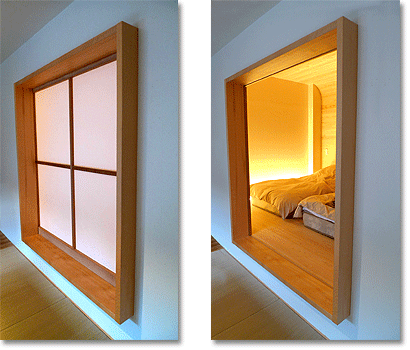
Contemporary Japanese bedroom in Hakone, Kanagawa Prefecture (Japan):
The entrance is concealed by a sliding shoji screen. © left & right: Marc Phu
Because of their striking looks, shoji (and so-called tatami beds
) are used in the West as can't-fail ingredients for Asian inspired bedrooms.
Finally, here's an entirely contemporary Japanese 'Zen bedroom': a sleeping-dining-entertaining-meditation area in a tiny open-plan apartmment in Tokyo:
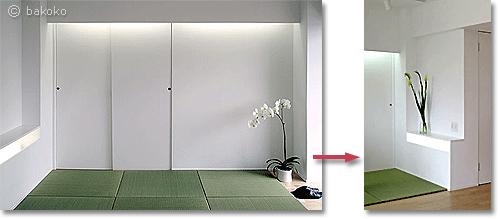
Tatami area in an open-plan apartment in Tokyo (Japan). © bakoko
As you can see in the smaller photo to the right, this 'bedroom' is open to the rest of the apartment. However, it retains the feel of a separate space by virtue of the tatami flooring. The beautiful new green mats don't have the traditional tape edging to avoid unnecessary pattern in this small space.
Atmospheric Decor For A Japanese Bedroom
In the days before electricity, a floor lantern used to be the main light source in a Japanese bedroom. Here's an electric version:
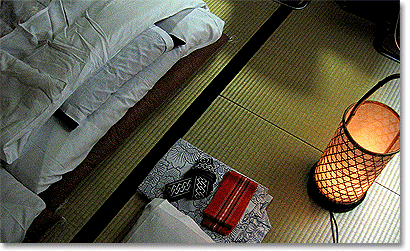
Japanese bedroom in Arashiyama, Kyoto (Japan):
Floor lantern on tatami mats. © Steven Luftman
Another atmospheric element that continues to be used in contemporary Japanese bedroom design is a shoji screen. Here's a closeup of the design:
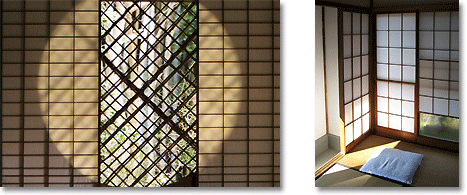
Shoji & lattice screens. (© left: Mrhayata, © right: Michael Cornelius)
Shoji are used in Japanese interiors ...
- as sliding/hanging doors for rooms and built-in closets;
- as window coverings, and
- as room dividers.
- (If you want to create fitted shoji screens for your windows, built-in closets or sliding doors, do check out these SHOJI books
on Amazon.)
Related Pages (Click A Pic):
Japanese Decorating: Bookshop
If you would like to add a traditional Japanese touch to your home, check out this mini bookshop (in partnership with Amazon):
For not-necessarily-Asian-inspired 'Zen bedroom' designs, try a book or two from this collection:
- Create a Japanese 'Zen bedroom', just by losing stuff:
How To Organize Clutter
- Using color in traditional Japanese interiors:
Neutral Color Schemes - The Book:
Neutral color palettes are a perfect fit for a Japanese bedroom, but they're not as straightforward as many people think. Understand what makes neutral color schemes look their best, and what happens when you mix neutral color palettes with more saturate decorating colors. It's FREE!! -
Understand Interior Design Styles:
a) Interior Design Styles List
b) Interior Decorating: Style vs. Fashion

